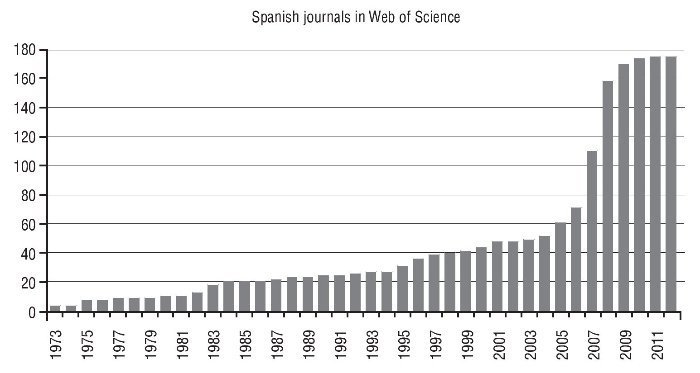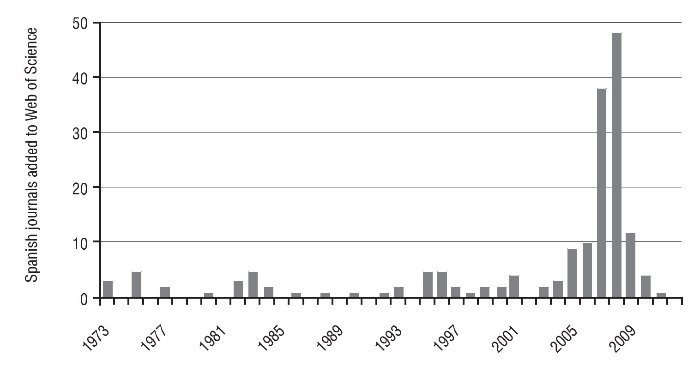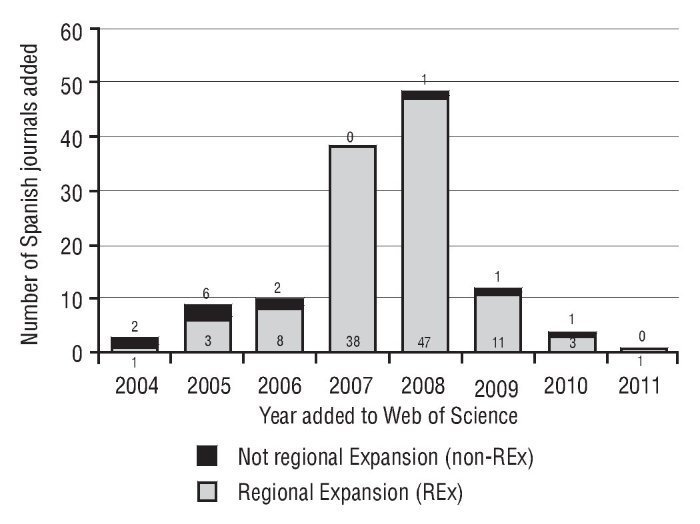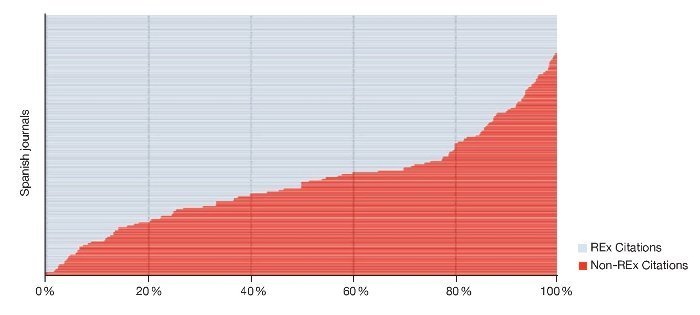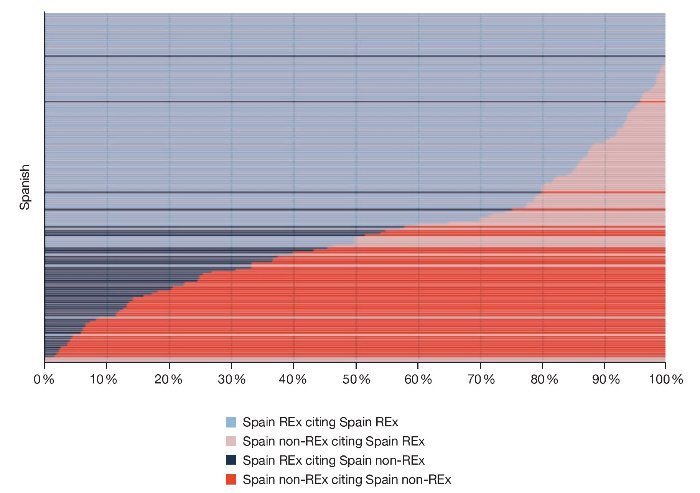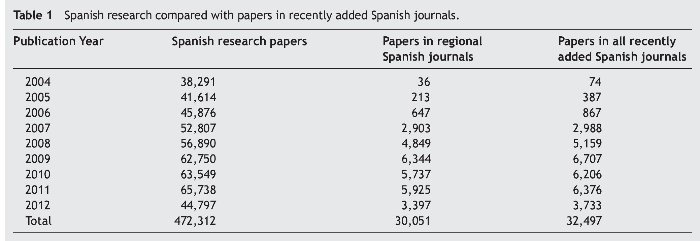La expansión de contenido regional de la Web of Science de Thomson Reuters (ante-riormente ISI) indexó aproximadamente 1.600 revistas en la base de datos con un enfoque regional en contraposición al internacional. La cobertura de la Web of Science ha crecido para reflejar la naturaleza cambiante de las tendencias globales de las publicaciones de investigación y ofrecer mayor visibilidad a estudios locales con alta calidad, más allá de las barreras tradicionales, a través de la incorporación de revistas regionales. Las referencias indexadas que son citadas en las revistas regionales representan la influencia de las revistas en las comunidades científicas, tanto globales como locales. Este estudio analiza el impacto de la indexación de revistas regionales españolas en la Web of Science sobre la publicación y patrones de citación de la investigación española. Los hallazgos demuestran un incremento reciente en la producción investigadora de España, no solo debida a la indexación de revistas españolas, sino principalmente a una mayor producción científica del país; de hecho, esto se demuestra porque la mayoría de las investigaciones españolas no se publican en revistas de dicho país. El análisis de las citaciones de las revistas de España descubre una red de citación regional no detectada previamente y que proporciona una valiosa información para los evaluadores de revistas españolas.
The regional content expansion of Thomson Reuters (formerly ISI) Web of Science added approximately 1,600 journals to the database with a regional as opposed to international focus. Web of Science coverage has grown to reflect the changing nature of global research publication trends and the additional regional journals provide greater visibility to high quality local studies beyond their traditional boundaries. The cited references indexed from the regional journals represent the influence of those journals on both the global and local research communities. This study analyses the impact of adding Spanish regional journals to Web of Science on the publication and citation patterns of Spanish research. The findings demonstrate a recent increase in research output from Spain and this is explained by more Spanish research being produced rather than due to the indexing of more Spanish journals; indeed it is shown that the majority of Spanish research is not published in Spanish journals. An analysis of Spanish journal citations uncovers a Spanish regional citation network previously undetected and serves as valuable information for evaluators of Spanish journals.
Pagina nueva 1
Publication and citation analysis of journal content indexed in Thomson Reuters Web of Science (WoS) together with other performance indicators (e.g., Buela-Casal, Olivas-Ávila, Musi-Lechuga, & Zych, 2011) has acquired increasing relevance among the research community for purposes of evaluation due in part to the selectivity of the journals indexed in the database. As a result of this trend, importance has been given to analyses of the indexed journals as these can be informative about their level of international scope (Buela-Casal & Zych, 2012), about the relative citation behaviour between different research areas (e.g., Buela-Casal et al., 2009; Zych & Quevedo-Blasco, 2011) and can help researchers to choose the most appropriate journal for dissemination of their research findings (e.g., Carbonell & Calvo, 2009).
Access to Web of Science for the Spanish research community is provided by a national subscription to defined Web of Knowledge databases through the Fundación Española de Ciencia y Tecnología (FECYT).
Web of Science is a combination of online bibliographic database and a citation index comprised of all the cited references from each of the indexed research papers in the database. This second part is what makes the database a citation index and is searchable via the interface as the Cited Reference Search. Traditionally, journals have been selected for inclusion in Web of Science based on a series of criteria, one of which is the impact of the journals in their specific field of research. As this is difficult to measure subjectively on a large scale, citations to a journal are used as a proxy for the impact of the content of that journal on the research community. This information is valuable to the selectors of journals for inclusion in Web of Science who can use this principle to support their evaluation of journals by counting the citations to the journal.
Many journals in the database are international in their scope and visibility and are therefore often cited by other international journals. In more recent years however, publishing patterns have evolved in response to the changing nature of global development. High quality research is now produced and published all over the world in both international and regional journals and in many languages. A growing proportion of cited references from Web of Science journals target work published at a national or regional level and this has led to a corresponding shift in journal selection policy for Web of Science.
A policy of regional expansion was developed for the Web of Science database with the aim of identifying and evaluating journals that can be defined as having a regional scope in terms of editorial content and readership. The regional content expansion entailed an analysis of the cited references from all Web of Science indexed journals and subsequently identified 10,000 cited journals with a definable regional scope that were not at that time indexed in the database. These 10,000 journals were then evaluated against the full set of Web of Science selection criteria and 1,601 of the journals were accepted for addition to Web of Science (Testa, 2010a). This study looks at the regional journals from Spain that were accepted and at the subsequent impact on journal and article numbers and on the citation patterns revealed as a result of the regional expansion in Spain. A Spanish journal can be defined as being published by a Spanish publisher or if the balance of editorial board members, subject matter or authors are concentrated in Spain.
Since the launch of the first citation index in 1963, the cited references from the indexed journals have provided insight into which journals are considered influential by the global research community and those highly influential non-indexed journals have then been evaluated for potential addition to the database. The regional content expansion has allowed that information to penetrate national and regional communities and expose the collective opinion of those researchers. Thus each time a new journal is added to Web of Science, it adds not only new content but also provides information via the cited references on the relative influence of journals both inside and outside the database on the research community. It is those influential journals that are then considered for inclusion in the database.
The incorporation of journals in Web of Science that focus specifically on Spanish readership and/or content has a beneficial side effect which is to provide information via the cited references on the journals that have most impact on the Spanish research community. This information may then be systematically evaluated to support the selection of journals for addition to the database.
The relationship between Spanish research and Spanish journal content is examined. It has been proposed that the increase in Spanish research published in WoS is largely due to the increase in coverage of Spanish journals (e.g., Quevedo-Blasco, 2013). Spanish research can be defined as research that takes place by a researcher or researchers in Spain which may or may not be published in a Spanish journal. Similarly, research published in a Spanish journal may or may not have been undertaken by researchers in Spain.
The objective of this study was first to examine the nature of the regional expansion of Web of Science concerning Spanish journals and evaluate its effect on the characteristics of the Spanish research indexed in Web of Science; second, to test the hypothesis that the increase in output of Spanish researchers is due to the recent addition of Spanish journals to Web of Science; and third, to look at the cited references indexed from the regional Spanish content and determine whether or not authors of papers publish in Spanish journals generally cite other Spanish journals, i.e., whether the regional content expansion has uncovered the presence of a regional citation network.
Method
A list of 325 Spanish journals indexed in Web of Knowledge databases was obtained and refined. It can be seen that 175 of these journals are indexed in Web of Science and a subset of 116 of these are classed as regional expansion (REx) journals. This classification has been made based on the editorial scope of the journal along with a careful analysis of the editorial boards, authors, content and citation origin of each journal. The remaining 59 Spanish journals have been included in the database but these are more international in their scope and are not part of the regional content expansion (non-REx).
The number of Spanish journals in Web of Science was counted for each year (Figure 1) and the first year of indexed content was determined for each Spanish journal (Figure 2) to show the change in representation of Spanish journals over time in the database. Spanish journals added to Web of Science since 2004 were described as either part of the regional content expansion (REx) or more international in scope (non-REx) (Figure 3).
Figure 1 Cumulative total Spanish journals in Web of Science over time.
Figure 2 Spanish journals added to Web of Science by year.
Figure 3 Spanish journals added to Web of Science since 2004 that were part of the regional content expansion (REx).
Spanish research papers were counted using the Web of Science Advanced Search function and the CU = Spain command. This was then compared with the number of papers in the regional Spanish journals and with the number of papers in all Spanish journals first indexed in 2004 or later including both regional and recently added non regional Spanish journals (Table 1 and Figure 4). Spanish research output is defined as any paper indexed in Web of Science with a minimum one author with an affiliation in Spain. More than one Spain-based address still counts as one Spanish paper. Research papers count were performed as CU = Spain using the Advanced Search option in Web of Science. No other limitations were applied.
Figure 4 Spanish research compared with research in recently added Spanish journals (including both regional content expansion and non-regional content expansion journals).
Cited references were counted from the papers in all Spanish journals and defined by their inclusion in the regional content expansion (REx) or not (non-REx). The number of unique cited works was also presented (Table 2). An analysis of all cited references from Spanish journals to works in Spanish journals showed the proportion of the citations that came from the Spanish REx journals compared with those that came from the Spanish non-REx journals (Figure 5). A deeper analysis highlighted whether the citations from Spanish REx journals were to other Spanish REx journals or to Spanish non-REx journals (Figure 6). All cited references from Spanish journals were collected over a two year period, 2010-2011 using the Web of Science cited reference search. The cited references were characterised as either citing Spanish REx journals or Spanish non-REx journals. Cited references to non-Spanish journals were not analysed further in this study.
Figure 5 Proportion of Citations to Spanish journals from Spanish regional content expansion (REx) vs. non-REx journals.
Searches for journal content were performed in the Web of Science database via the Thomson Reuters Web of Knowledge v5.8 platform (formerly known as ISI) using the publication name as the only search parameter. Full journal titles were used and multiple journal searches were combined using the Boolean ´OR´ operator. All searches were performed during the second half of October 2012.
Results
Web of Science includes content from 175 Spanish journals. 116 of these are classed as regional expansion (REx) journals. The remaining 59 Spanish journals included in the database are more international in the scope and are not part of the regional content expansion (non-REx). As 10 of the non-REx Spanish journals were added in the same time period as the 116 REx journals, the total number of 'recently added journals' is 126. As shown in Figure 1 there has been a gradual increase in the number of Spanish journals indexed in Web of Science over time with a significant increase in the last 5 years.
Indeed, it can be seen in Figure 2 that the years in which most Spanish journals were added to the database were 2007 and 2008 with 38 and 48 journals added respectively.
With greater detail, Figure 3 shows the number of Spanish journals added since 2004 and the proportion of those journals that were added as part of the regional content expansion (REx). In 2007, 100% of Spanish journals added were regional and in 2008, the corresponding proportion was 97.9%.
In Table 1, the number of papers published by researchers based in Spain is shown by year and also the number of papers published in regional Spanish journals and the papers published in all journals recently added to Web of Science.
It can be seen that the number of Spanish research papers greatly outnumbers the quantity of papers in the journals recently added from Spain (Figure 4).
In Table 2, the number of cited references from Spanish journals in 2010 and 2011 is displayed and organised by Spanish journals in the regional content expansion (REx) and Spanish journals not in the regional content expansion (non-REx).
In Figure 5, the Spanish citations to Spanish journals are shown based on whether they come from Spanish REx or Spanish non-REx journals. Figure 6 then shows that a large proportion of those citations to Spanish REx journals come from other Spanish REx journals.
Figure 6 As Figure 5 with cited regional (regional content expansion [REx]) journals marked in darker colour.
Table 3 shows a breakdown of the Spanish journals by language. The regional journals use Spanish in 90% of cases whereas almost 60% of the non-regional journals use English as the primary or main language.
Discussion
As the number of scholarly journals has grown over time, so has the collection of those journals that are indexed in Web of Science. The criteria for selection of a journal for inclusion in Web of Science include adherence to good publishing standards, timeliness, a valuable editorial contribution to the database and the impact of its content to the research community. The editorial board and authors are also of interest when defining the scope of a journal in that their diversity can be taken as an indicator of the scope of content and intended readership of the journal. Thus if a journal is presented as international in scope then one would expect to see international representation in the editorial board, authors and topics treated in the journal. If the scope is more regional or national then again, that would be usually seen in the diversity of the editorial board, authors and content. The impact of a journal is often measured by analysis of the citations to the papers published in the journal, the more citations received, the higher the impact of the content. However, deeper analysis needs to be taken to define the origin of the citations to gain a fuller understanding of the impact. A regional journal that targets a more local audience will by default have a limited volume of readers and sphere of influence and therefore one would expect to see fewer and more localized citations. Analysis of Web of Science journals has shown an increased number of citations to such regional journals which is indicative of research with significant impact, hence the recent effort to include more of such journals via the regional content expansion of Web of Science.
The number of Spanish journals indexed in Web of Science has grown steadily over time with the expansion of the database (Figure 1) with a sharp increase over the past decade. By mid-2012, there were 175 Spanish journals indexed in the database. In comparison with other countries, more Spanish journals were added to the database between 2005 and 2010 than any other country except United States, United Kingdom, The Netherlands and Germany Other countries whose coverage increased significantly include Brazil and Australia. (Testa, 2010b). This growing coverage has an influence on the indicators used by different studies (e.g., García-Pérez, 2010; Olivas-Ávila, Musi-Lechuga, Quevedo-Blasco, & Luna-Hernández, 2012; Villar, 2011) and Spanish universities (e.g., Olivas-Ávila & Musi-Lechuga, 2012).
The regional content expansion has resulted in 116 Spanish journals and their 30,051 research papers being added to Web of Science between 2004 and 2012 (Figure 2). During the same time period, a further 10 journals from Spain were added to Web of Science but these were not part of the regional content expansion. The recently added Spanish journals in Web of Science (including both the 116 regional expansion journals and the 10 non-regional expansion journals), have brought an additional 32,497 research papers to the database. The recently added Spanish journals account for 72% of the 45,104 papers published in Spanish journals in that time period. It can therefore be said that the majority of content from Spanish journals indexed in these years is regional in nature.
In the same period, researchers based in Spain published 472,312 papers (Table 1 and Figure 4). It was shown that annual Spanish research productivity grew by 27,447 Web of Science papers over the past 8 years to a total of 65,738 papers in 2011. This increase is only fractionally explained by the addition of the 5,925 papers from the regional journals. Even adding all papers from all recently added Spanish journals in the 8-year time period means that 6,376, only 23% of the increase in Spanish research output can be explained by the addition of Spanish journals to the database. This evidence refutes the claim that the increase in Spanish research published is due to the increased coverage of Spanish journals. More than three quarters of the increase in Spanish research output is explained by the fact that researchers based in Spain have published more research and that this research has been published mainly in international journals (including international journals that are based in Spain).
As with all Web of Science papers, each cited reference has been indexed in the citation index and it can be seen that from the 116 Spanish regional expansion journals indexed in Web of Science, the 30,051 research papers include 278,010 cited references (Table 2) which can be found in the cited reference search. The selection criteria for a journal to be added to Web of Science include evidence that the journal contains influential content and this may be shown by the presence in the cited reference search of cited references that cite the journal under evaluation. The citation networks among international journals have become established and the influence of many journals is easily recognizable by the number of citing papers found in the cited reference search. Citation networks linking regional or local journals are however less well established and one of the main consequences of the regional content expansion is the illumination of the citation networks at regional level. In the case of Spain, there are now 278,010 additional cited references from Spanish regional journals that point clearly to literature considered influential by the Spanish research community. This is new information that can now inform the Web of Science editors to support their decisions when evaluating journals for inclusion in Web of Science.
An analysis of cited references to Spanish journals (Figure 5) showed the distribution of those citations from Spanish regional journals (REx) and Spanish non-regional (non-REx) journals. The horizontal lines in blue at the top of the graph show those Spanish journals receiving all their Spanish citations from those journals defined as regional in their scope. These journals therefore contain content that has influenced researchers publishing at a regional level rather than the global research network. This may be partially explained by the issue of language as 91% of the Spanish regional journals use Spanish as their main or sole language for publication (Table 3). Those researchers who read and are influenced by these papers will either be competent in Spanish and or go to the effort of obtaining a translation into their language of comprehension. Most of the Spanish non-REx journals on the other hand are considered more global in their scope and 59% of them use English as their sole or main publication language which widens the potential readership and therefore raises the possibility of influencing non-Spanish speakers. Widening the potential readership can increase the citations received by the journal and therefore its associated indicators such as the Journal Impact Factor (González-Alcaide, Valderrama-Zurián, & Aleixandre-Benavent, 2012) or downloads (e.g., Jamali & Nikzad, 2011; Moed, 2005; Watson, 2009). Cited references from these non-regional journals are represented by the red bars more concentrated at the bottom of the graph and from where some Spanish journals receive the majority of their Spanish citations. Once the identity of the cited journals was revealed (Figure 6), it was shown that those journals receiving the majority of their Spanish citations from regional journals were themselves mainly the regional journals. This evidence supports the existence of a regional citation network between Spanish journals that is not noticed at global level.
Conclusion
Spanish research productivity in Web of Science has increased sharply in the past 8 years and this is due mainly to the increased publication in international journals by researchers in Spain. The Web of Science regional content expansion has added 116 Spanish journals to the database that focus on Spanish content and/or readership. The cited references indexed from these regional Spanish journals have made the Spanish regional citation network visible and illuminated the journals considered influential by the Spanish research community. Selection of journals for inclusion in Web of Science is in part based on their influence on the research community and the exposure of the Spanish regional citation network can now be used effectively to support future decisions on indexing of Spanish journals.
Acknowledgements
With special thanks to Marie McVeigh, Director of JCR and Bibliographic Policy, Thomson Reuters who provided the data, valuable advice and guidance used for the citation analyses presented in this article.
*Corresponding author at:
Thomson Reuters, C/ Provença 398, 08025 Barcelona, Spain.
E-mail address:philip.purnell@thomsonreuters.com (P.J. Purnell)
Received January 11, 2013;
accepted March 22, 2013
References
Buela-Casal, G., Olivas-Ávila, J., Musi-Lechuga, B., & Zych, I. (2011). The h index of the presidents of the American Psychological Association (APA) through journal articles included in the Web of Science. International Journal of Clinical and Health Psychology, 11, 95-107.
Buela-Casal, G., & Zych, I. (2012). How to measure the internationality of scientific publications. Psicothema, 24, 435-441.
Buela-Casal, G., Zych, I., Medina, Viedma del Jesús, M. I., Lozano, S., & Torres, G. (2009). Analysis of the influence of the two types of the journal articles; theoretical and empirical on the impact factor of a journal. Scientometrics, 80, 265-282.
Carbonell, X., & Calvo, N. (2009). Las revistas españolas de psicología: Cómo elegir la revista donde publicar. Anales de Psicología, 25, 209-216.
García-Pérez, M. A. (2010). Accuracy and completeness of publication and citation records in the Web of Science, PsycINFO, and Google Scholar: A case study for the computation of h indices in Psychology. Journal of the American Society for Information Science and Technology, 61, 2070-2085.
González-Alcaide, G., Valderrama-Zurián, J. C., & Aleixandre-Benavent, R. (2012). The Impact Factor in non-english-speaking countries. Scientometrics. doi:10.1007/s111192-012-0692-y. Jamali, H. R., & Nikzad, M. (2011). Article title type and its relation with the number of downloads and citations. Scientometrics, 88, 653-661.
Moed, H. (2005). Statistical relationships between downloads and citations at the level of individual documents within a single journal. Journal of the American Society for Information, Science and Technology, 56, 1088-1097.
Olivas-Ávila, J. A., & Musi-Lechuga, B. (2012). Doctorados con Mención de Excelencia en Psicología: evidencia en tesis doctorales y artículos en la Web of Science. International Journal of Clinical and Health Psychology, 12, 503-516.
Olivas-Ávila, J. A., Musi-Lechuga, B., Quevedo-Blasco, R., & Luna-Hernández, J. R. (2012). Índice de Internacionalidad de las revistas iberoamericanas de Psicología en el Journal Citation Reports (2011). Revista Latinoamericana de Psicología, 44, 175-183.
Quevedo-Blasco, R. (2013). Revistas iberoamericanas de Psicología indexadas en el Journal Citation Reports de 2011. Revista Mexicana de Psicología, 30, 1-10.
Testa, J. (2010a). The Globalization of Web of Science. Available from: http://thomsonreuters.com/products_services/science/ free/essays/regional_content_expansion_wos/http:// thomsonreuters.com/products_services/science/free/essays/ regional_content_expansion_wos/ [retrieved 2 Mar 2013].
Testa, J. (2010b). The Globalization of Web of Science: 2005-2010. Available from: http://wokinfo.com/products_tools/ multidisciplinary/webofscience/contentexp/expansionessay/ [retrieved 2 Mar 2013].
Villar, A. (2011). El eigenfactor: un nuevo y potente instrumento bibliométrico para evaluar la investigación. Aula Abierta, 39, 85-96. Watson, A. B. (2009). Comparing citations and downloads for individual articles. Journal of Vision, 9, 1-4.
Zych, I., & Quevedo-Blasco, R. (2011). A decade of the International Journal of Clinical and Health Psychology (2001-2010). International Journal of Clinical and Health Psychology, 11, 549-561.





